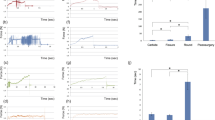Abstract
Objectives
Ultrasonic surgery is an increasingly popular technique for cutting bone, but little research has investigated how the ultrasonic tip oscillations may affect the cuts they produce in bone. The aim of this investigation was to evaluate the oscillation and cutting characteristics of an ultrasonic surgical device.
Materials and methods
A Piezosurgery 3 (Mectron, Carasco, Italy) ultrasonic cutting system was utilised with an OP3 style tip. The system was operated with the tip in contact with porcine bone samples (loads of 50 to 200 g) mounted at 45° to the vertical insert tip and with a water flow of 57 ml/min. Tip oscillation amplitude was determined using scanning laser vibrometry. Bone surfaces defects were characterised using laser profilometry and scanning electron microscopy.
Results
A positive relationship was observed between the magnitude of tip oscillations and the dimensions of defects cut into the bone surface. Overloading the tip led to a reduction in oscillation and hence in the defect produced. A contact load of 150 g provided the greatest depth of cut. Defects produced in the bone came from two clear phases of cutting.
Conclusions
The structure of the bone was found to be an important factor in the cut characteristics following piezosurgery.
Clinical relevance
Cutting of bone with ultrasonics is influenced by the load applied and the setting used. Care must be used to prevent the tip from sliding over the bone at low loadings.






Similar content being viewed by others
References
Salami A, Dellepiane M, Crippa B, Mora R (2010) A new method for osteotomies in oncologic nasal surgery: Piezosurgery. Am J Otolaryngol 31:150–153
Arnez J, Papa G, Renzi N, Ramella V, Panizzon N, Tonanetti F (2009) Use of piezoelectric bone scalpel in hand and reconstructive microsurgery. Acta Chir Plast 53:207–214
Horton JE, Tarpley TM (1981) Clinical applications of ultrasonic instrumentation the surgical removal of bone. Oral Surg 51:236–241
Sortino F, Pedullà E, Masoli V (2008) The piezoelectric and rotatory osteotomy technique in impacted third molar surgery: comparison of postoperative recovery. J Oral Maxillofac Surg 66:2444–2448
Lea SC, Walmsley AD (2009) Mechano-physical and biophysical properties of power-driven scalers: driving the future of powered instrument design and evaluation. Periodontol 2000 51:63–78
Felver B, King DC, Lea SC, Price GJ, Walmsley AD (2009) Cavitation occurrence around ultrasonic dental scalers. Ultrason Sonochem 16:692–697
Parmar D, Mann M, Walmsley AD, Lea SC (2011) Cutting characteristics of ultrasonic surgical instruments. Clin Oral Impl Res 22:1385–1390
Lea SC, Landini G, Walmsley AD (2004) Assessing the vibrations of dental ultrasonic scalers. J Sound Vib 271:1113–1120
Pavlíková G, Foltán R, Horká M, Hanzelka T, Borunská H, Sedý J (2010) Piezosurgery in oral and maxillofacial surgery. Int J Oral Maxillofac Surg 40:451–457
Romeo U, Del Vecchio A, Palaia G, Tenore G, Visca P, Maggiore C (2009) Bone damage induced by different cutting instruments—an in vitro study. Braz Dent J 20:162–168
Cardoni A (2010) Enhancing oral implantology with power ultrasonics. IEEE Trans Ultrason Ferro Freq Cont 57:1936–1942
Alam K, Mitrofanov AV, Silberschmidt VV (2011) Experimental investigations of forces and torque in conventional and ultrasonically-assisted drilling of cortical bone. Med Eng Phys 33:234–239
Khambay BS, Walmsley AD (2000) Investigations into the use of an ultrasonic chisel to cut bone. Part 1: forces applied by clinicians. J Dent 28:31–37
Lucas M, MacBeath A, McCulloch E, Cardoni A (2006) A finite element model for ultrasonic cutting. Ultrasonics 44:503–509
Acknowledgments
This work was undertaken as part of the UK Engineering and Physical Sciences Research Council grant (EP/F50053X/1) with the title, LSI DTCs 2007: Physical Sciences of Imaging in the Biomedical Sciences (PSIBS).
Conflict of interest
The authors declare that they have no conflict of interest.
Author information
Authors and Affiliations
Corresponding author
Rights and permissions
About this article
Cite this article
Claire, S., Lea, S.C. & Walmsley, A.D. Characterisation of bone following ultrasonic cutting. Clin Oral Invest 17, 905–912 (2013). https://doi.org/10.1007/s00784-012-0754-9
Received:
Accepted:
Published:
Issue Date:
DOI: https://doi.org/10.1007/s00784-012-0754-9




